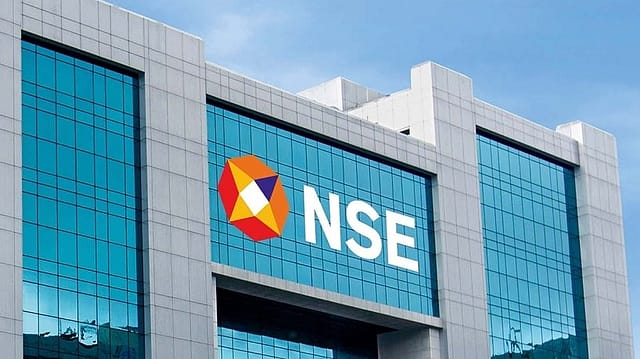NSE 500 companies clock record profit, corporate earnings growth outpaces GDP of India
ADVERTISEMENT

On the back of impressive performance by banking sector, Nifty 500 companies clocked a record profit of ₹11.1 lakh crore in FY23, a rise of 8.8% over FY22 earnings of ₹10.2 lakh crore. Public sector banks registered a record profit of ₹1.1 lakh crore while Private Banks clocked ₹1.3 lakh crore profit in FY23.
The corporate profit to GDP ratio in India had been contracting since 2010, except for 2017 when profits of global cyclical sectors such as metals and oil & gas rebounded, and losses of public sector undertaking (PSU) banks reduced compared to the preceding year. India's corporate profit (listed plus unlisted) to GDP ratio dropped to 2.0% from 7.8% over the period of 2008-20. For the Nifty-500 Universe, the ratio declined to 2.3%, reaching a two-decade low, from 5.1% over the same period.
Interestingly, from FY14 to FY20, NSE 500 Profit remained range bound at ₹4 lakh crore to ₹5 lakh crore. However, NSE 500 Profit experienced a remarkable jump to ₹10.2 lakh crore in FY22. Nifty 500 represents 92% of India's market capitalization.
Despite registering an all time high profit in FY23, the corporate profit to GDP ratio for both the Nifty-500 Universe and listed India Inc. contracted marginally to 4.1% and 4.3% respectively, after reaching a decade high of 4.3% and 4.5% in 2022. This decline was primarily driven by global commodities, which adversely affected the ratio.
January 2026
Netflix, which has been in India for a decade, has successfully struck a balance between high-class premium content and pricing that attracts a range of customers. Find out how the U.S. streaming giant evolved in India, plus an exclusive interview with CEO Ted Sarandos. Also read about the Best Investments for 2026, and how rising growth and easing inflation will come in handy for finance minister Nirmala Sitharaman as she prepares Budget 2026.
The reduction in the FY23 profit to GDP ratio for the Nifty-500 was led by the metals sector with a 0.4% decline, followed by the oil & gas sector with a 0.3% decline. However, the profit of the banking, finance and insurance (BFSI) sector improved by 0.4%.
Though in FY23, nominal GDP growth of 16.1% (YoY basis) was faster than FY23 corporate profit growth of 8.8% but in the long run the compound annual growth rate (CAGR) of corporate profit has surpassed the CAGR of the Indian economy. Between FY18 and FY23, corporate profit registered a CAGR of 17.6% while India's GDP recorded a CAGR of 9.8%. Even during the period of 2020-23, corporate profit CAGR at 34.3% was significantly higher than the GDP CAGR at 10.7%.
The corporate profit for the Nifty-500 Universe recorded 49% growth in FY22 and 50% in FY21. India's GDP grew at 18.4% in FY22 while it contracted in FY 21.
A Decade of Trends
Brokerage firm Motilal Oswal recently published a report that examined the corporate profit in the last 20 years. It divided the last 20 years into three phases.
In Phase-I (from FY03 to FY08), the corporate profit to GDP ratio nearly doubled to 5.1% from 2.7%, with Nifty-500 profits reporting 30% growth, twice the pace of underlying GDP growth (CAGR of 14.5%). This surge was driven by export, investment, and capex-oriented sectors, as the global economy grew at a faster rate, supporting export-oriented players, and capacity investments across sectors took off steadily. The top five contributors to profit delta during this phase were RIL (Reliance Industries Limited), Tata Steel, SAIL (Steel Authority of India), DLF, and Bharti Airtel.
In Phase-II (2008-2020), distress in domestic corporate earnings led to a compression in the Nifty-500 profit to GDP ratio to 2.3% from 5.1% earlier. Sectors such as oil & gas, metals, PSU banks, telecom, and capital goods were responsible for 88% of this decline.
The metals sector has experienced significant fluctuations in profitability since 2008. In 2013, the profitability dropped to 0.2% from 0.7% in 2008 and hit its lowest point in 2016. The sector's profitability is closely tied to commodity prices, and it has fluctuated accordingly. From 2016 to 2019, the sector saw a substantial increase in profitability due to rising commodity prices and deleveraging in some major companies.
The profitability of the telecom sector plummeted due to increased competition after the entry of Reliance Jio. This, combined with higher capital expenditure and lower operating margins, pushed the sector into losses.
The profit-to-GDP ratio for NBFCs (non-banking financial companies) consistently expanded over the last decade, with the Nifty-500 NBFC Universe achieving an 18% compound annual growth rate (CAGR) from 2008 to 2020.
During Phase-II, key stocks that contributed to the decline in the profit-to-GDP ratio were Oil and Natural Gas Corporation (-12%), Bharti Airtel (-10%), Tata Steel (-9%), RIL (-7%), and Indian Oil Corporation Limited (-6%).
During Phase-III, the profit-to-GDP ratio improved for 20 out of 25 sectors. The major drivers of this improvement were PSU Banks (22%), private banks (20%), telecom (11%), metals (8%), insurance (8%), and oil & gas (7%). Only the cement, media, and consumer durables sectors witnessed a compression in the ratio.
India's earnings cycle has seen a significant turnaround after nearly a decade. Nifty exited FY23 with 11% earnings per share (EPS) growth, following a high base of 34% growth in FY22. However, earnings remained lopsided with BFSI driving almost the entire incremental earnings in FY23.
The revenue compound annual growth rate (CAGR) for Nifty-500 from FY20 to FY23 stood at 14.8%, primarily driven by global commodities and the automobile industry.
